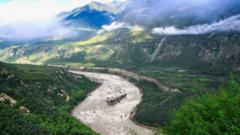The approval of the Yarlung Tsangpo hydropower dam marks a significant expansion in China's renewable energy ambitions, projected to generate three times the output of the existing Three Gorges Dam. However, human rights organizations are cautious, citing the potential displacement of local populations and environmental disruptions. Despite assurances from Chinese authorities about environmental safeguards and local economic boosts, concerns regarding the ecological landscape of Tibet remain acute, alongside apprehensions about increasing control over transnational river flows affecting neighboring India and Bangladesh.
China's Ambitious Plans for World's Largest Hydropower Dam in Tibet

China's Ambitious Plans for World's Largest Hydropower Dam in Tibet
China's government has greenlit the construction of a massive hydropower dam in Tibet, raising alarm over environmental consequences and community displacement.
The dam will be situated in the lower phases of the Yarlung Tsangpo River, renowned for its profound canyon and steep gradients that lend themselves to potent hydropower generation. While Chinese media herald the project as a pivotal advancement towards carbon neutrality, dissenting voices argue that the venture could further penetrate local populations already subjected to systemic restrictions. A backdrop of earlier protests against hydropower initiatives highlights the tense relationship between local Tibetan communities and the central government in Beijing.
With the installation anticipated to necessitate considerable tunneling through mountainous terrains and subsequent adjustments of the river flow, experts warn that the undertaking could result in significant geological risks, particularly in earthquake-prone areas.
Concerns are amplifying, as China forges ahead with energy projects in the region without extensive transparency regarding community impacts. As geopolitical tension surrounds river resource control, particularly with India voicing its readiness to counter any adverse ramifications from China's development, the Yarlung Tsangpo dam will undoubtedly become a focal point in debates over energy security, environmental sustainability, and human rights in the region.
With the installation anticipated to necessitate considerable tunneling through mountainous terrains and subsequent adjustments of the river flow, experts warn that the undertaking could result in significant geological risks, particularly in earthquake-prone areas.
Concerns are amplifying, as China forges ahead with energy projects in the region without extensive transparency regarding community impacts. As geopolitical tension surrounds river resource control, particularly with India voicing its readiness to counter any adverse ramifications from China's development, the Yarlung Tsangpo dam will undoubtedly become a focal point in debates over energy security, environmental sustainability, and human rights in the region.























